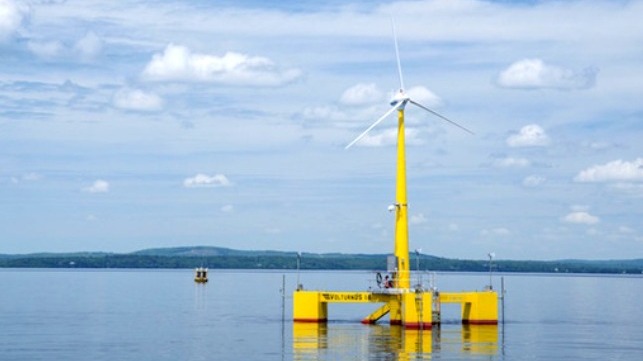Maine’s Floating Wind Turbine Research Project Clears BOEM Hurdle

Maine’s efforts to launch an innovative research project to advance the use of floating offshore wind turbines took a step forward at the end of last week. The Department of the Interior’s Bureau of Ocean Energy Management (BOEM) issued a ruling moving the project a step closer to its offshore lease and meaning it can proceed to an environmental review.
Fifteen months ago, the State of Maine applied for a small, distant offshore lease that would be used as the test site for the New England Aqua Ventus project. They are seeking to test the University of Maine's patented floating offshore wind technology. A prototype wind turbine has already been built and tested in near-shore waters.
Under the proposal to BOEM, the research area would involve 15.2 square miles in the deep ocean 29 miles from the nearest mainland point of Cape Small, and 45 miles from Portland, Maine. The state’s governor while critical of near-shore projects has supported this more research project. The state said the site was selected following an extensive public outreach process, which included an analysis by the Maine Department of Marine Resources that helped identify areas that minimized known potential impacts on the fishing industry.
The research proposal submitted to BOEM in October 2021 calls for a lease of 9,700 acres on the U.S. Outer Continental Shelf in a location more than 20 nautical miles off the Maine coast. If developed, the research site would consist of up to 12 floating offshore wind turbines capable of generating up to 144 megawatts (MW) of renewable energy.
BOEM issued a “Determination of No Competitive Interest” on January 19 for the proposed research lease area offshore Maine. This came after the agency issued a Request for Competitive Interest (RFCI) in the Gulf of Maine in August 2022. They reported that the agency received complete submissions to the RFCI from two qualified entities. However, following a careful review of the submissions, BOEM concluded there was no competitive interest in the RFCI area due to concerns about commercial scale viability in the proposed research lease area.
The next steps for processing the research application include publishing the Determination of No Competitive Interest in the Federal Register and initiating an environmental review of potential impacts from offshore wind leasing activities associated with the research lease. BOEM reports it is hosting a series of meetings in January to solicit feedback on the Draft Call Area and is tentatively planning to host the next Gulf of Maine Intergovernmental Renewable Energy Task Force Meeting in the spring of 2023.
The agency acknowledges that the research project would develop information that could be used to inform any future commercial offshore wind development in the Gulf of Maine, as well as the deployment of floating offshore wind technology nationwide. Floating wind has also been cited as the likely technology to support the development of offshore wind farms after California’s first wind area auctions in 2022. The focus on floating wind turbines is increasing both in the United States and elsewhere as companies look at developments further from shore or areas where ocean floor conditions are more challenging for the fixed bottom technology used today.
